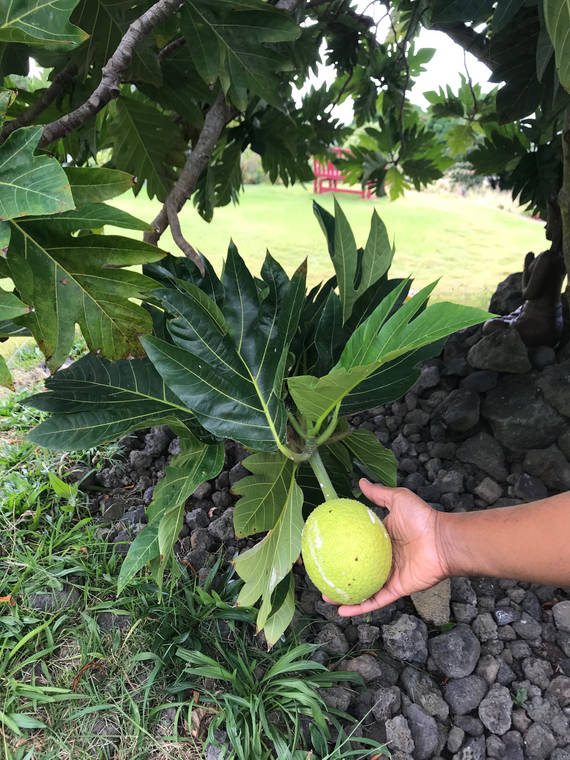This past week was an amazing one with Easter, Earth Day, the Merrie Monarch Festival and the Hawaii Chocolate Festival all happening. What they have in common is that they all relate to the rebirth, renaissance and evolution of life and culture.
Our Hawaii gardens also represent the continuing influence of many diverse cultures creating a new experience. The earliest gardens were composed of plants Polynesians brought with them from Asia, the vast Pacific and even South America.
It is theorized that the first people might have come from Africa to Taiwan and between, thousands of years ago. This mix of ethnicities is extremely complicated and continues to this day as we share our islands.
What was it like for the first Polynesian pioneers who found these islands?
The forests in those earliest days of human activity were very different than when Captain Cook arrived. What is now open grasslands used to be forests. Trees such as loulu palms flourished in abundance, but it wasn’t long after that the Polynesian introduction of pigs and rats radically changed things.
There still remain at least 24 species endemic to Hawaii, but for all we know there could have been scores more. All remaining species are threatened with extinction unless we intervene by planting them in our gardens and parks.
With the later arrival of herbivores such as goats, sheep and cattle, even more damage was done to the forests.
We have no real clear records of the early times, but throughout Polynesia it is obvious that humans and the animals and plants they brought with them have had a tremendous impact on the species that evolved here. Today, erosion is a big problem on most high islands, and the rising ocean is swallowing low atolls that have been the homes of islanders for thousands of years.
Rebirth and evolution continue to happen, as is taught to us by our active volcanoes.
The moral is that we must learn to adapt to change while at the same time keep as many of the good qualities of the past where we can. This remains true as we face the challenges of climate change, population increase causing land use issues and protecting our unique natural resources and culture.
Our parks and gardens reflect this complicated evolution of life and culture. We have a wide variety of plants, native and those introduced by many different ethnicities. By keeping the lush vegetation an integral part of our communities, we actually do our part to fight pollution, global warming and make life more enjoyable.
As individuals, one of the easiest ways to decrease the carbon dioxide levels in the atmosphere is to plant trees. There are a number of trees that can help accomplish this. Among the best are natives such as the loulu palms, ‘ohi‘a, hala, wiliwili, hoawa, alahe‘e and a‘ali‘i.
Other plants, such as the beach and mountain naupaka, are attractive to many birds and also make good ornamentals for gardens. Flowers of the ‘ohi‘a, koa, hau, milo and mamane might even attract some native nectar feeding birds such as ‘i‘iwi, amakihi, apapane and ‘elepaio.
The hala tree is another tree of interest and beauty. It can be grown from sea level to at least 3,000 feet elevation.
Lauhala, or leaf of the Pandanus, has probably been used for thousands of years. Not only are the leaves used for walls, floor mats and thatched roofs, today artists weave purses, shopping bags and hats with them.
Even the parts of the fruit were eaten during periods of food shortage. Today, island campers will use the fibrous segments as a toothbrush.
The Pandanus family, closely related to palms, is found throughout the Old World tropics. There are hundreds of species, from miniature shrubs to large trees. Most can be distinguished by their aerial roots. These roots give them the common name of “walking trees.”
In Hawaii, we have two common native Pandanus species. The puhala, Pandanus odoratissimus, is found naturally growing along many coastal areas. The mountain ‘ie‘ie, Frecynetia arnotti, is found climbing vine-like up ‘ohi‘a trees in mauka forests, sometimes 80 feet or more.
Another group of plants to consider are those the Polynesians brought with them, such as coconut, kukui, mountain apple, banana, sugarcane, bamboo and breadfruit. These include hundreds of varieties and are referred to as canoe plants.
Remember that our gardens can and should reflect the best of Hawaiian culture while at the same time recognizing that the Polynesian migrations around the Pacific evolved as time and the environment demanded.
Thus Maori, Samoan, Tongan, Marquesan, Tahitian, South Asian and maybe even South American influences also are part of the ongoing human migration and have a prominent place in our gardens.



